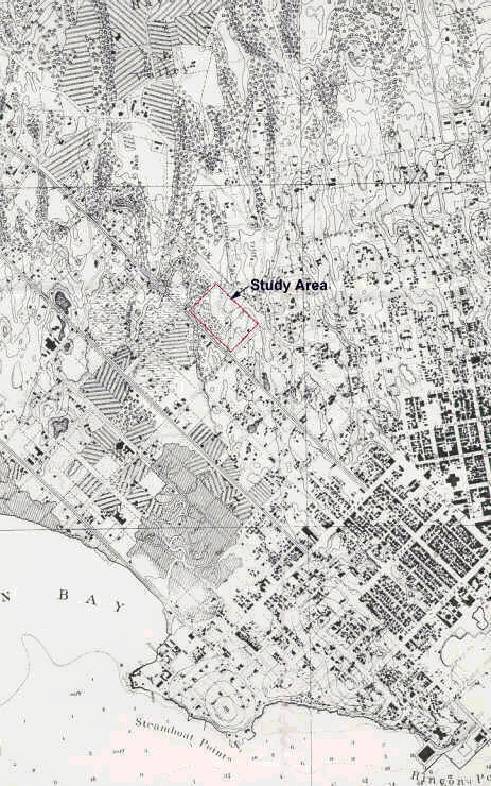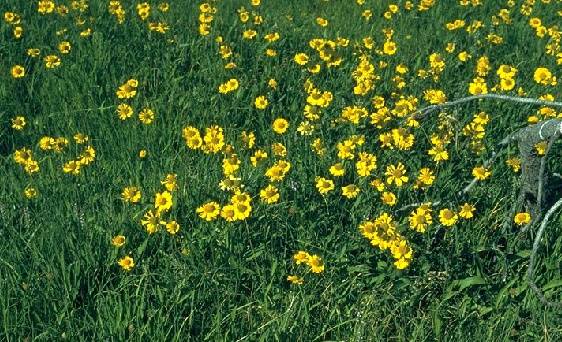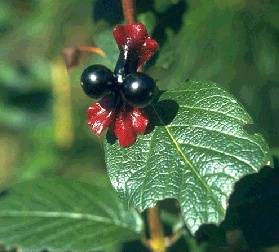Botanical Reminiscences of South of Market, 1896
1857 Map of the South of Market area. The red rectangle outlines the area discussed in "Botanical Reminiscences". Second Street runs from center bottom to the right side of the map, hitting Market Street where the word "street" is printed. The Second Street cut is right where the vertical line intersects Second.
The landscape which extended in the years 1850 to 1860 from Mission Creek to the range of hills at present split by the Second Street cut, was in its greater part filled by swamp and bog and Salicornia flat. A turfy fresh-water formation, inland, gradually merged into the Salicornia flat and was crossed by the serpentine courses of the tide creeks.
This formation was the basis for a system of sand downs overgrown by shrubbery, or occasionally arborescent vegetation. The downs were mostly arranged in parallel ridges, the ridges being most numerous and frequently confluent towards the mouth of Mission Creek. There were no sand downs on the other side, and its vegetation exhibited an entirely different character, depending on hills of serpentine rock and its debris.
In the direction of the range, now crossed by the Second Street cut, the sand hills diminished in number and size, the ridges became gradually isolated and stopped entirely at a wide flat, in a locality which is now bordered by Sixth and Third Streets, and entered in a very deep, boggy branch, the sand down region, beyond what is now Mission Street.
The ridges which enclosed this branch were higher than the rest and reached in considerable elevation the line of Howard Street, where they formed a very abrupt boundary between sand and bog.
The deep, boggy branch that crossed Mission Street, where the swamp formed a valley encircled by deep downs, was the seat of a peculiar, now almost extinct Flora, at least as regards the neighborhood of San Francisco. This locality was the only one inhabited by the now extinct Arenaria palustris, which grew there in company with Bides chrysanthemoides, Cicuta californica, Oenanthe californica, Hydrocotyle, Nuphar polysepalum, Typha latifolia.
An arm of this swamp, then inaccessible, even to cows, followed the side of Howard Street, down, bordering the flat as far as what is now Fifth Street, where it became overgrown by arborescent vegetation and ended in a thicket of Myrica californica, Ceanothus thyrsiflorus, Garrya elliptica, Salix sp., Woodwardia radicans, Asplenium filix-femina, Aspidium aculeatum, and Aspidium munitum, the latter with almost arborescent trunk.
As a curiosity, we have to mention several shrubby specimens of Cornus nuttallii, now entirely extinct in this region, its nearest habitat being Bolinas Ridge in Marin County, and even there it is not common.
There were several valleys beyond the steep ridge which bordered the swamp towards the West. Their chief direction was parallel to the ridge and they were dry and grassy. Their vegetation was about the same as that found now on spots where it has been protected in the cemeteries and Golden Gate Park.
It was in this region where a few specimens of Botrychium ternatum grew, a plant of the Sierras, now entirely extinct in our vicinity. The chief difference between the vegetation of this region and that of the sand downs and vales, similar to those now protected by the enclosure of Golden Gate Park was the great abundance of annuals, most of them strictly vernal. I recollect chiefly the different species of Erythroea, then frequently collected and much thought of by the old inhabitants, who used all the species, under the name Conchalagua, against the intermittent fevers, dyspepsia, etc.
Rosilla (Helenium puberulum) Photo: Margo Bors
This vegetation disappeared in summer without leaving any trace, and, only where subterranean water courses approached the surface, luxuriant branches of Baccharis douglasii, Erigeron philadelphicus, Aster chamissonis, and Helenium puberulum covered the ground, occasionally overspread by the flowering Twin-berry, Lonicera involucrata with its shining black berries in their dark red involucres, or Sambucus glauca and Ribes glutinosum.
Twin-berry (Lonicera involucrata) Photo: Margo Bors
These moist spots became confluent towards the North but towards the South the steep declivity of the ridge separated, in a very decided way, dry sand and inaccessible bog without any intervening transitional formation.
The bog itself was perceptibly lower at the foot of the hills than towards its center, which was occupied by a characteristic swelling of the turf, which gave origin to a net of interwoven little water-courses, permeating a kind of meadow and themselves covered by a moss-like carpet of an Azolla. The water seemed remarkably clear, but nevertheless deposited on the stems and lower leaves of grasses and herbs a thick ochraceous crust.
The vegetation of this locality was exceedingly characteristic. It was a kind of Arctic oasis amidst a vegetation of California type.
Where the water collected into small rivulets, it became hidden under the dense, mossy, and very deceiving carpet of Azolla. The turf consisted to a great extent of Cyperaceae, especially Scirpus, Carex, and, in one locality, even an Eriophorum. Out of this turf emerged the fragrant Habenaria leucostachys and Menyanthes trifoliata and, in one locality, Epipactis gigantea, with Sisyrinchium bellum. These were the most conspicuous and at the same time the most frequent plants of the formation.
Where the rivulets approached and extended to the serpentine course of the tide water creek, the formation changed; the Azolla carpet dissolved into floating islands before disappearing entirely, the grasses and Cyperaceae lost their dense turfy appearance and developed higher stems with more conspicuous inflorescence and fewer leaves. Only on the margin of the creeks was developed the characteristic luxuriant turf of Distichlis maritima, frequently grown over by Grindelia robusta.
Then followed the Salicornia flat, here and there ornamented by Cordylanthus maritimus and Frankenia grandifolia, abruptly ending in a boggy marsh without any vegetation. Here was the mouth of the serpentine creek, the receptacle of all the watercourses of the flat.
The mouth of the creek was bordered on its left side by a flat ridge of coarse, dry sand without grass, but sparsely overgrown by Frankenia, Statice limonium var. californica and Heliotropium curassavicum.
Species entirely extinct in this region and not found elsewhere: Arenaria palustris, Watson. (This may, some day, be rediscovered in Alaska).
Species extinct in this region but found in other parts of California:
Menyanthes trifoliata, L.
Heliotropium curassavicum, L.
Cornus nuttallii, Audubon.
Epipactis gigantea, Dougl.
Fimbristylis miliacea, Vahl.
Botrychium ternatum, Swartz.
Eriophorum (species unknown).
Arbutus menziesii Pursh. This consisted of a single specimen at the brim of one of the ridges, about twenty feet above the turfy level of the swamp, in a locality now covered by Seventh Street, between Harrison and Folsom. It was a straggling tree growing amidst shrubby Quercus agrifolia and Ceanothus thyrsiflorus only to be distinguished from Heteromeles when in flower.
--Hans Herman Behr, 1896



